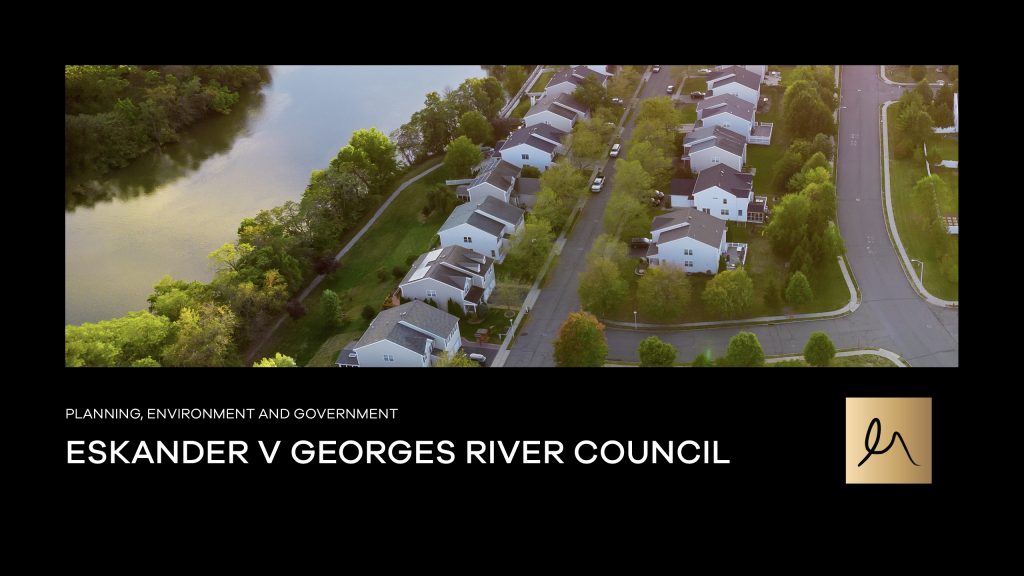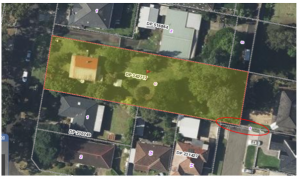In the recent decision of Eskander v Georges River Council [2024] NSWLEC 1006 the Land and Environment Court dealt with two issues that frequently arise in the assessment of development applications. The first issue concerned the size of a basement storage area considered reasonable for the purposes of a dwelling house. The second issue concerned vehicular access to a land locked site. In this decision the Court provides guidance on how these issues might be dealt with by a consent authority.
The Facts
Mr Eskander sought development consent for the construction of a detached dual occupancy on his land. Dwelling one contained six bedrooms and a study, an outdoor pool and two levels and a void of basement storage with a floor area of 517.2 m2. Mr Eskander intended to use the lower basement level as storage for “large format” artworks. Dwelling two was smaller in scale with two-storeys containing two-bedrooms and a combined living and dining room. Georges River Council failed to determine Mr Eskander’s DA within 40 days. Mr Eskander lodged a deemed refusal appeal to the Land and Environment Court.
Basement Size and Use
The Council contended in the appeal that the proposed base was characterised as an art gallery, which was a prohibited use. Council also contended that the extent of excavation for the basement was excessive and unacceptable.
At the hearing Mr Eskander also amended the design to reduce the basement floor area and provide setbacks to a number of important trees on the site.
The Council considered that the basement area was excessive and incompatible with the current character of buildings in the street which comprised single and two-storey dwellings with garages primality at street level. The Council’s expert took issue that the excavation does not follow the natural topography of the existing ground level and opined that the basement was an attempt to circumvent the height and floor space ratio development standards in the Georges River LEP 2021. Further, the Council’s expert considered that an excavation of the degree proposed was not common in low density residential areas and its approval would present an undesirable precedent.
The Court rejected the Council’s submissions on the size of the basement. The Court concluded there were no streetscape or character impact from the size of the proposed basement and the extent of excavation, given that the works were predominately underground and within the footprint of the aboveground works. There were no adverse impacts on adjoining properties as a result of geotechnical or drainage considerations. Each level of excavation was within the footprint of the works on the levels above and at least 1208 mm away from the boundary with adjoining properties.
On the issue of characterisation, the Court held that the use of the basement for storage of the occupant’s private art collection was consistent with the residential purpose of the dual occupancy and there was not a “skerrick of evidence” that visitors would be received at the premises so as to constitute the use as an “art gallery”.
Vehicular Access
Vehicular access to one of the dwellings traversed a narrow parcel of land (owned by the Council) separating the site from David Place. The Council contended that the Court had no power to grant development consent because access to the dwelling the dwelling did not satisfy clause 6.9 of the Georges River LEP 2021. That clause required the Court to be satisfied that vehicular access to the site “was available or adequate arrangements had been made to make it available when required”. Sensing an opportunity to bolster its case, the Council also refused to grant Mr Eskander a right of access over the narrow parcel of land or give its permission as landowner to the use of its land.
The narrow strip of land can be seen circled in red in the extract from maps.six.nsw.gov.au below:
The Council contended that the Court could not be satisfied that vehicular access to the second dwelling was available or adequate arrangements had been made to make it available when required because Mr Eskander had no right of access over the Council land and Council had no intention of giving it to him (despite the fact that a driveway existed on the land which was used by Mr Eskander).
The Court decided that clause 6.9 was satisfied. The Court noted that Mr Eskander had earlier made an application to the Court under section 40 of the Land and Environment Court Act 1979, which was pending determination, requesting the Court grant a right of carriageway in favour of his land over the narrow parcel of land. The section 40 application provided a means by which legal access could be obtained. The Court also found there was no physical or strategic planning impediment to the granting of the right of carriageway. The Court further noted that it had the power to exercise the Council’s function as landowner to give landowners consent to lodgement of the application.
The Court granted the development consent subject to a deferred commencement condition requiring the registration of a right of carriageway.
Encountering issues like these in your development projects? Let our specialists assist you.
If you’re facing similar development challenges or planning disputes, reach out to Madison Marcus Law Firm’s specialist division. Our dedicated team is equipped to deliver results that protect and maximize your property’s potential. Contact us today to ensure your development projects align seamlessly with legal requirements and strategic objectives.
MM Website Enquiry Form
Form used to capture all MM website enquires. Will be used in Monday and Mailchimp via Zapier
"*" indicates required fields








